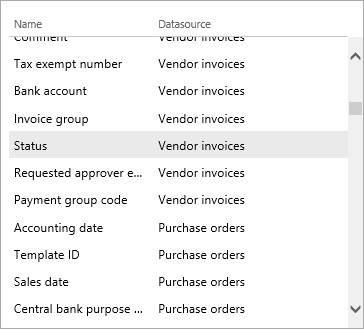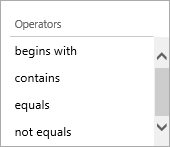If you want to allow users configure certain conditions by themselves, considering using the Expression Builder control.
This is how it looks like:

It exists already in AX 2012, where you can add it through the ManagedHost control. AX 7 doesn’t support managed controls anymore, but the Expression Builder has been redesigned and it’s now available as a native AX control.

The control allows you to add and remove conditions and combine them with AND and OR operators.
You can select fields, possibly from several tables.

Then you choose an operator – which operators are available depends on field’s data type.

And finally you select a value. It will give you a lookup for available values, if applicable.
Some data types are handled in a special way. For instance, fields with data types extending Money gets an additional field for currency, and the amount is converted to the right currency for comparison at runtime.
![]()
Dealing with dates is even more complex. You can either pick a fixed date:

or define a date relatively to the current date or the current month:

In addition, Expression Builder understands surrogate keys, expands financial dimension fields to individual dimensions and has a support for hierarchies.
If you want to see an example in the standard AX application, look at Organization administration > Workflow > Work item queue assignment rules.
A bit of technical details
To be able to use your own tables in Expression Builder, you have to define an AOT query (that’s where fields are taken from) and a class (“document”) inhering from WorkflowDocument.
If you want to add Expression Builder to your own form, you have to add a little bit of code, most importantly to indicate which document class (and – indirectly – which query) it will use. Expression Builder has ExpressionDocumentClass() method for that. Then you also need some logic for loading and saving expressions – look at an existing implementation for details.
The document class can have a few useful attributes and it can also define calculated values, which are then displayed in the list among normal fields. Calculated fields are important – not only they allow you to do any kind of calculation, but you can also use them to work around limitations of what expression you can write.
Consider this scenario: You want to define a condition for ShippingDate > Deadline. How can you put the Deadline field on the right side of an expression in expression builder? You can’t (or at least I haven’t figured out how), but you can create a calculated field, such as DaysToShipDeadline, defined as Deadline – ShippingDate. Then it’s trivial to configure the condition as DaysToShipDeadline < 0.
When your expression is defined and saved, you can call Expression::evaluate() to see if the condition it true or false for a given record:
ExpressionResultType result = Expression::evaluate( 'usmf', // Company tableNum(MyTable), // Table where is the record to check 5637144576, // ID of a record in MyTable expressionId, // From ExpressionTable ExpressionDataSources::newExpressionDataSources());
This indicates a problem with how conditions are evaluated. Because you always provide only TableId and RecId, the evaluation logic must always make a query to database. If you need to run it once, it’s not a big deal, but if you’re evaluation many expressions, it may become a problem. To make it worse, methods for computed fields and the currency convertor also get only TableId and RecId, making additional DB queries. Caching helps a bit, but it’s still all quite expensive. I consider making a child expression class accepting a temporary buffer (or buffers) instead of just a record ID; the first prototype suggests it’s feasible and worth the effort.
If you’re interested in inner workings of the evaluation, let me give you a brief overview:
- AX executes the query defined in the document class, filtered by RecId provided by the caller.
- Data returned by the query (plus calculated values) are put into a XML document.
- When you save your rule in Expression Builder, the condition is converted to an XPath query and saved to ExpressionTable.XPathQuery field. For evaluation, AX simply runs the XPath query against the XML document and returns the result.
- XPath syntax there has a few extra functions, such as ConvertAmountValue() calling X++ class ExpressionCurrencyDefaultProvider.
If you want more details, you can look at source code, because most of it is available to you.
- Expression Builder control is built in the same way that you can use to build your own controls. The runtime class is SysExpressionBuilderControl, its HTML code is in SysExpressionBuilderControlHTM resource, and so on.
- A lot of logic of logic regarding saving and loading expressions is directly on ExpressionTable table. saveExpression() is a good example.
- The evaluation is done mainly in SysExpression class (which unfortunately isn’t designed to be easily extensible).
Some logic is also contained in Microsoft.Dynamics.AX.Framework.Model.dll.
It looks useful, doesn’t it?
Hi Martin,
It looks nice. Do you know if you can use it to combine fields? For example: Street + housenumber or qty * amount? It seems to run only as a condition.
As you test always the limits, you’ve maybe tested this too? 🙂
Johan
You can’t, AFAIK. If you look at it from the implementation perspective, what XPath query would you write, for example, for Qty * Amount? You need to have this in the queried document, but that’s defined at design time, by the query and the document class. You can easily add a calculated field (parm method) to the document class, return Qty * Amount from there and let users query the result. But users can’t create calculated fields for themselves.
thanks a lot!
I’m trying to implement this on the MCRHoldCodeTable form and I’ve looked at examples on existing forms and it’s still not clear to me. Are there any actual step by step instructions on how to implement this?
I’m not aware of anything more detailed than this blog post. If you’re still struggling, consider explaining your particular problem in a discussion forum (I participate in https://dynamicsuser.net/ax/f and https://community.dynamics.com/365/financeandoperations/f/765).
As far as I understand, expression builder can only evaluate boolean expressions (as conditions). Is there any adequate tool for building and evaluating non-boolean expressions for final users?
For example while developing electro-billing model we need some kind of expression builder to build expressions for disbalances calculation.
Hi Martin,
Hope your are doing well.
I have a question regarding expression. Is there a way a can convert the dynamic expression (created/saved) to a dataset?
Example: I want the build dynamic expression based on a criteria(s) and publish the results to a form.
I’m sorry, but I’m not sure what you mean. Could you please create a thread in a discussion forum (such as https://community.dynamics.com/365/financeandoperations) and explain your requirement in detail there?